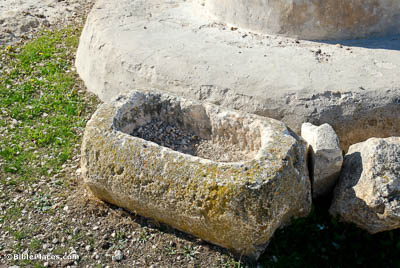I wanted to share the exciting news that my dear friend, Dr. Gary Byers,has written an exceptional article for the new Harvest Handbook of Bible Lands about the Christmas story. We worked together for over 15 years in Egypt, Israel and Jordan. I am proud to announce that this Handbook offers a comprehensive survey of the history, geography, and culture of the Scriptures and is edited by Joseph M. Holden and Steven Collins both of whom I worked with at Tall el-Hammam. It was published by Harvest House in 2020. In addition to Dr. Byers' contribution, I have also written several articles for this incredible handbook. I highly recommend it to anyone interested in deepening their understanding of the Bible.
I have also contributed several articles to this wonderful Handbook.
Away in a Manger, but Not in a Barn
by Gary Byers, PhDJoseph, a descendant of King David, journeyed to Bethlehem, his ancestral home, with espoused wife Mary to participate in a mandatory census (Luke 2:3). In the ancient Near East, a family’s historic ties to their hometown were of upmost importance. Since he was of the royal line of David, space would have been found for Joseph and family upon arrival in the city. Even in the Roman period, the Davidic connection to Bethlehem was so strong that Bethlehem was still known as the “City of David” (Luke 2:4,11).
Even as Mary was Joseph’s espoused wife and close to giving birth, accommodations for a direct descendant within the Davidic ancestral home was not unreasonable. Furthermore, as Luke noted earlier, Mary had relatives nearby in the “hill country of Judea” (Luke 1:39). With Jesus being born “while they were there” (Luke 2:6), it seems possible that there may have been time for such alternate arrangements.
 |
| https://www.bibleplaces.com/luke2/ |
Although no barn is mentioned in the text, the “manger” (Greek phatna) is prominent (Luke 2:7, 12, 16). Stone-carved and plastered mangers are known on the ground floor of domestic structures in Israel throughout biblical times (1 Samuel 28:24; Judges 11:31). Historians and anthropologists have noted the practice of keeping animals in the house down through history. While flocks were kept in sheepfolds out in the fields (Luke 2:8), valuable or vulnerable animals (oxen, donkeys, sick or pregnant sheep and goats) would be brought into the house’s ground floor domestic stable. Such was the place where infant Jesus would have been laid in a manger.
Luke records, “there was not room for them in the inn” (‘inn’ is Greek kataluma; Luke 2:7). The only other New Testament mention of a kataluma is as the upper chamber “guest room” of a Jerusalem house where the Last Supper was held (Luke 22:11; parallel Mark 14:14). There is no reason why Luke’s use of the term in 22:11 (“guest room”) on the last night of Jesus’ life should be different from his use of the same term in 2:7 (“inn”) on the first night of Jesus’ life. His statement “no room for them in the inn” indicates that the “guest room” of the house where Mary and Joseph were staying was already full. The NIV’s 2011 revision acknowledges this fact, changing “inn” to “guest room” (2:7).
 |
| Artist’s impression of a 1st century AD house in Palestine. |
Luke knew what a public inn was, using that term in the account of the Good Samaritan at an “inn” (pandocheion; 10:34) with an “innkeeper” (pandocheus; 10:35). His use of kataluma indicates an altogether different kind of space: the “guest room” of a family home. Thus, Luke’s nativity account had no barn (or lean-to!), no statement by an innkeeper, nor even an innkeeper! Instead, at that first Christmas baby Jesus was placed in a manger on the ground floor of a Bethlehem house—surely among family—because the upstairs “guest room” was already full.
For more discoveries that highlight the biblical text see The Archaeology of the Old Testament and The Archaeology of the New Testament:
**Dr. Gary Byers serves as a faculty member at Veritas International University (VIU) School of Archaeology. He also serves as the Assistant Director and Senior Archaeologist of the Shiloh Excavations and Assistant Director of the Tall el-Hammam Excavation Project, Jordan (since 2005). He has previously worked at Khirbet el-Maqatir (1995-2014), Khirbet Nisya (1993-1994) and Tel Miqne/Ekron (1984) in Israel. An adjunct professor at Trinity Southwest University (Albuquerque, New Mexico) and Faith Theological Seminary (Baltimore, Maryland), Gary has undergraduate and graduate degrees from Liberty University (Lynchburg, Virginia) and a graduate degree from Baltimore Hebrew University (Baltimore, Maryland).
_________
 Follow me on Academia.edu or Selected Works
Follow me on Academia.edu or Selected WorksFor Books see Amazon or Amazon
Updated Dec 13, 2023





No comments:
Post a Comment